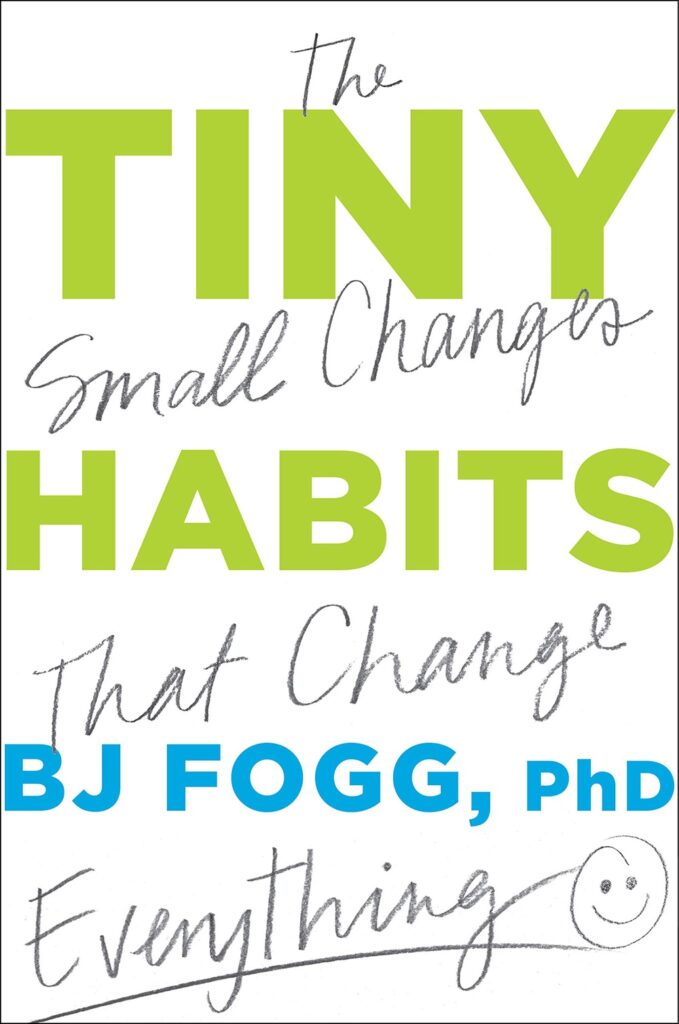Sharing my learnings from the book, Tiny Habits by BJ Fogg
Tiny Habits by BJ Fogg
Tiny Habits—created by Dr. BJ Fogg, a world-renowned Behavior Scientist at Stanford University—is based on 20 years of research and Dr. Fogg’s experience personally coaching over 60,000 people.
Unlike anything that’s come before, this system—what Dr. Fogg has coined “Behavior Design”—cracks the code of habit formation.
The content in this book is practical, immediately applicable and most importantly brand new. Tiny Habits is not just a summary of existing methods. Each chapter shares breakthrough insights and simple steps you can take to improve your life. All this is based on Dr. Fogg’s groundbreaking research in Behavior Design.
At the heart of this book is a startling truth: Creating a happier, healthier life can be both easy and fun.

- Every year, millions of people resolve to make positive changes in their lives. But then something happens. As the weeks go by, these new habits start slipping. We miss a day, then a week, then another. Soon enough, we’re back to square one. Stanford-based behavioral expert BJ Fogg has an answer: we simply take on too much at a time.
- there’s little evidence to support the idea that motivation is the sole key to changing behavior. This means that the real culprit isn’t you – it’s your approach to change.
- Try a different, two-step approach.
- stop blaming yourself. If you’ve found it hard to change in the past, you’ve probably been doing it wrong.
- you need to take your aspirations and break them down into manageable, bite-sized chunks.
- ”we are not the problem. Our approach to change is. It’s a design flaw – not a personal flaw”
- the Information-Action Fallacy. This is the notion that if you just give people the right facts, they will change their attitudes and behaviors. While it’s a neat theory, it unfortunately doesn’t really hold water in the real world; mere facts just aren’t enough.
- the author has found three answers in his research into habit formation:
- epiphanies meaning sudden revelations, are impossible to consciously bring about – unless you possess some kind of magical powers.
- environmental changes are often beyond your control
- tiny tweaks to existing habits – tiny habits are small actions that take less than a minute to complete. The idea is that starting small makes it easier to complete the task. And the more often you do that, the better you’ll feel. This creates a feedback loop that, over time, “wires in” new habits.
- Three key variables drive human behavior
- motivation – your desire to do something
- ability – your capacity to do that thing
- prompts – stimuli that trigger you to do it
- the easier a behavior is, the more likely you are to do it.
- here’s the thing about these big, one-off spikes of motivation: they’re perfect for doing hard things once. Sustainable change, however, means doing the same things day in, day out. Instead of concentrating on what they can do right now, they focus on aspirations (long-term goals).
- Aspirations are abstract outcomes; they tell you about the results you’re trying to achieve, not how you’re going to achieve them. And motivation alone won’t do the trick. Behavior is what bridges this gap between the present moment and the desirable future outcome.
- Simplifying desirable behaviors is a great approach to designing tiny habits. And the best way to do this is by looking at what makes the behavior in question hard to do. This will usually come down to one of several factors: time, money, physical capacity, mental energy, and the fit with your current schedule.
- When your ability to do something is low, you’ll only do it on days when you’re riding the motivation wave. And as we’ve seen, big motivation spikes are good for completing difficult, one-off tasks, but less effective for repeating behaviors again and again. This means you need to focus on ability when designing your tiny habits, and make them as simple as possible.
- ”simplicity changes behavior.. If a behavior frustrates you, it will not become a habit.”
- Wherever you are, you’re surrounded by prompts that trigger specific responses. This process is often unconscious – you just do something without giving much thought to why. And this automaticity presents a chance to cement positive changes in your life.
- Different types of prompts already exist in life
- contextual prompt, meaning a prompt in your environment.
- person prompt, meaning something inside you that tells you to perform a behavior.
- the most effective type of prompt is the action prompt. Action prompts are behaviors you already perform, which also prompt you to initiate new behaviors.
- The reason action prompts work is simple. Rather than trying to create new habits from scratch, you’re building on established routines. Best of all, they don’t require any thought.
- When designing your action prompts, consider location, frequency, and theme.
- The first thing to think about when you’re designing action prompts is physical location.
- Then there’s frequency. If your tiny habit is something you want to do once a day, choose something that happens once a day. On the other hand, if your tiny habit is something that you want to repeat more often, your prompt should be an action you perform multiple times.
- the best anchors are thematically linked to desirable behaviors.
- designing prompts is an experiment.
- The more you play around with forming habits, the better you get. When that happens, you’ll begin to feel those happy zings yourself. And that means you’re at least one small step closer to realizing your aspirations.


Leave a Reply